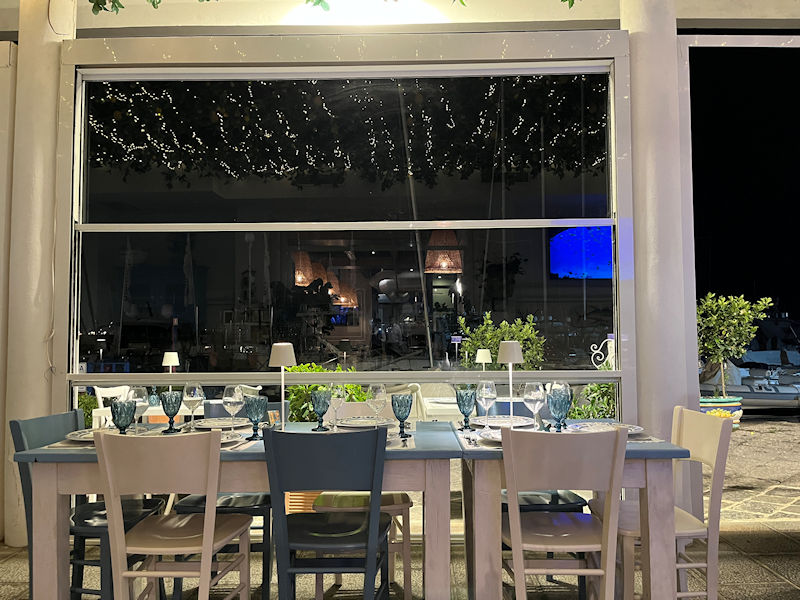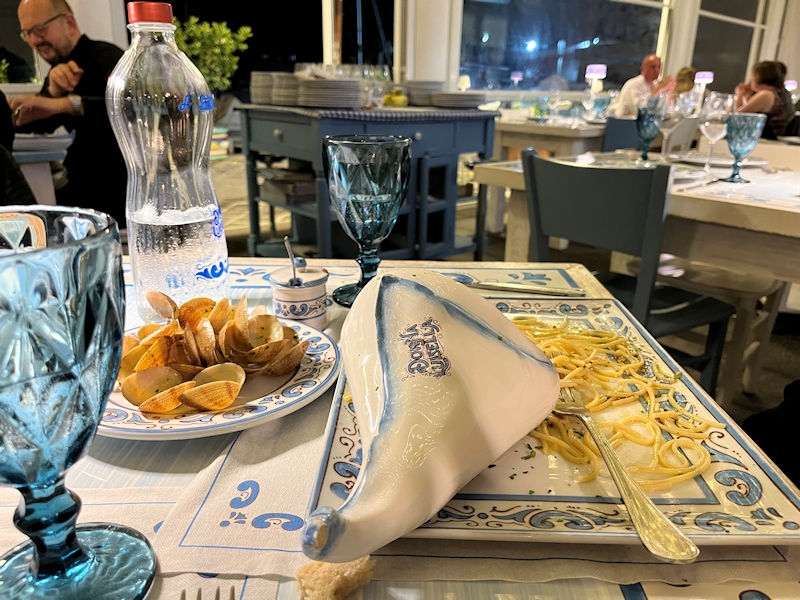You may not find this terribly rewarding unless you're included here, so this is a good time for casual and random browsers to turn back before they get too caught up in the sweep and majesty of the proceedings and can't let go.
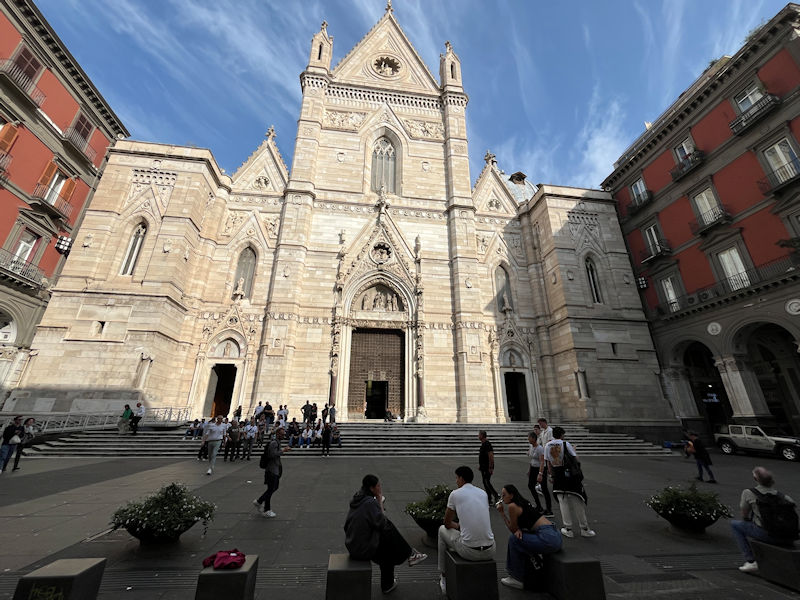
The Duomo di Napoli. Officially, it's the Cathedral of the Assumption of Mary (Cattedrale di Santa Maria Assunta), but it's also known as the Cattedrale di San Gennaro after St Januarius, the city's patron saint (whose blood turns to liquid from time to time, miraculously). But everyone calls it 'Il Duomo'.
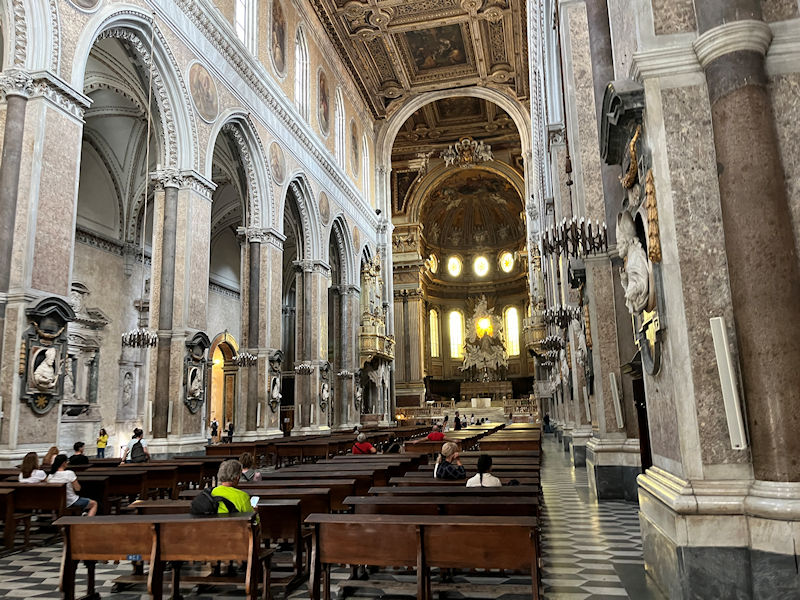
It was commissioned by King of Naples Charles I of Anjou (r. 1266-1285), in the Angevin Gothic style, and completed under his grandson Robert the Wise in the early 14th century. It was positioned on the foundations of two very early Christian basilicas, traces of which remain. The façade is said to have been renovated in Neo-Gothic style and only completed in 1905, though the central front door is from the 15th century.
The structural design of the interior is an ordinary Latin cross with a nave and two side aisles (aka 'three naves'). The apse boasts an enormous extravagant gilded sculpture of a throne with Mary ascending from it into . . . well, the dome perhaps. The gilding is so enthusastically done that it's a bit hard to see the thing clearly.
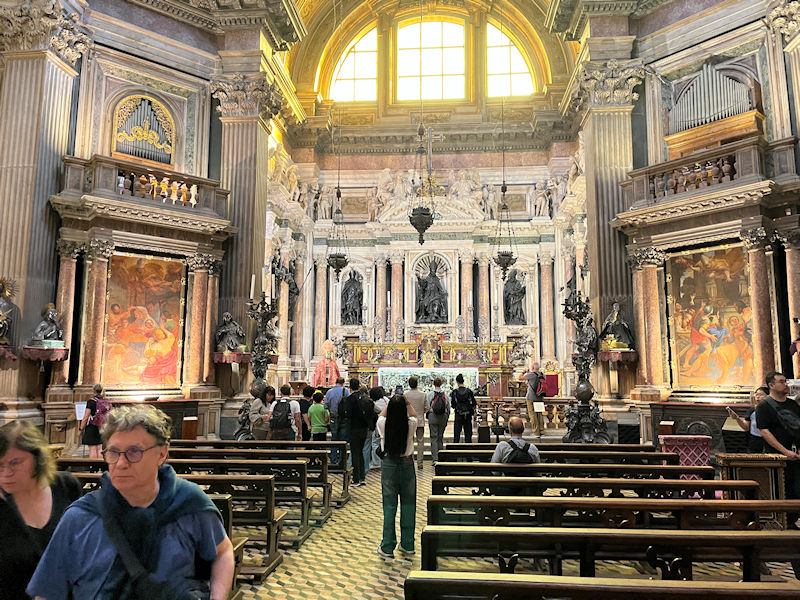
The Chapel of San Gennaro was created in the 17th century, with a life-size bronze statue of the patron saint in the centre niche and a reliquary of gold holding his skull on the left foreground, wearing a bishop's vestments and mitre. Completed in 1646, it was designed by the Theatine priest/architect Francesco Grimaldi.

Televising the miraculous blood. San Gennaro is said to have been serving as Bishop of Benevento when he was tortured and beheaded in nearby Pozzuoli in 305 during the Diocletian persecutions. He was made the patron of Naples in 472 for his protection in the eruption of Mt Vesuvius of that year. His tomb was moved from the Catacombs to the Duomo in the 9th century, and in 1497 other supposed remains were brought from other sites in Italy, including the skull and miracle-blood, eventually into his own chapel here.

It's the main centre of the Tesoro di San Gennaro, an attached outbuilding built 1608-1646, a Royal Chapel with its own dome, that houses most of the relics of the patron saint, aside from what's in the crypt. The 'treasure' includes lots of various artworks, but most importantly it's got the ancient 'ampoule' containing the blood of the saint, which is displayed three times a year, 'when the blood usually liquefies'. The tradition holds that if it does not liquefy, disaster will befall Naples.
In this and other cases of miraculously liquefying holy blood, the secular consensus is that the phenomenon is due to the presence of a suspension of hydrated iron oxide, which can be easily concocted and decreases in viscosity when stirred. That said, 'on March 21, 2015, the blood in the vial appeared to liquify during a visit by Pope Francis. This was taken as a sign of the saint's favour of the pope. The blood did not liquify when Pope Benedict XVI visited in 2007.'

A few (unidentified) side chapels, very nice


The dome of the Treasury, with frescoes by Domenichino and Giovanni Lanfranco in the 1630s.
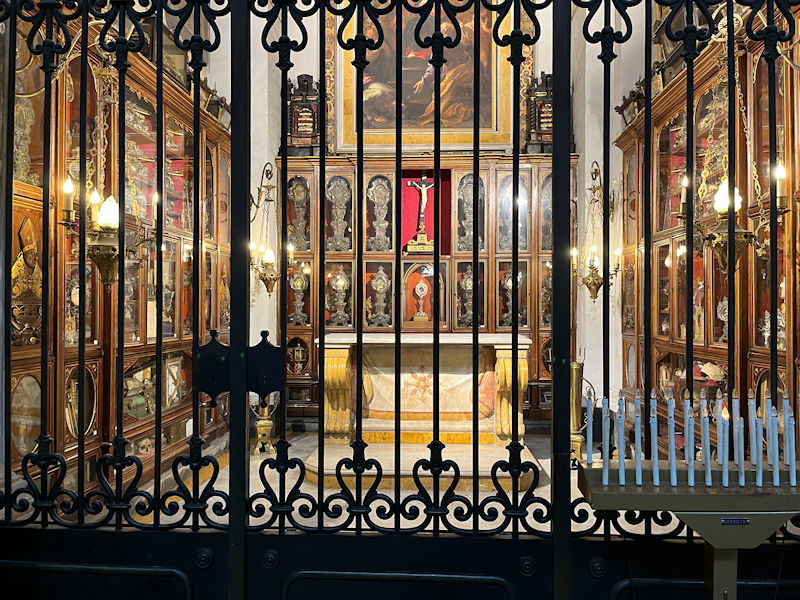
A room full of reliquaries. There is a whole 'nother building, with its own dome, attached to the main fabric of the Duomo, the Reale Cappella del Tesoro di San Gennaro ('the royal chapel of St Gennaro's treasures').
We haven't been inside that, as frequently such places are filled with ankle bones and demi-skulls and with musty old chasubles and mitres.

That's the side chapel tomb of Cardinal Francesco Carbone, who died in 1405. (We're great fans of spiral columns.)
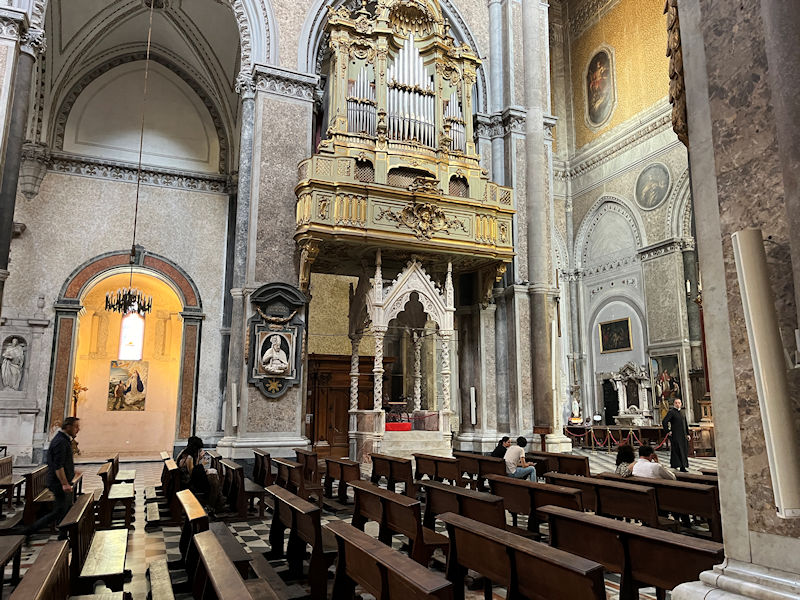
One of the organs and the ambo or pulpit below it, with a baldacchino covering it.

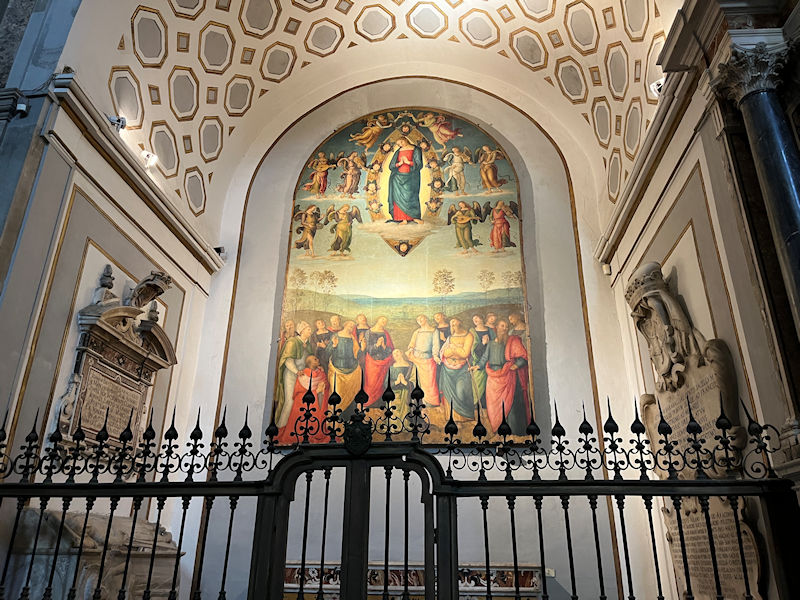
The altarpiece Our Lady of Assumption by Perugino

The Capece Minutolo Chapel, in the right corner of the presbytery or chancel, dates from 1301 and was built for the tomb of Archbishop Filippo Minutolo over a 5th century chapel dedicated to St Peter. The sarcophagus of Archbishop of Salerno Orso Minutolo was built on the left wall in the mid-1300s, when the chapel was still focused on St Peter, but in 1402 the Archbishop Enrico Minutolo entrusted the patronage of the chapel to the 'Capece Minutolo' family, where it remains; he himself joined the party with his own funeral monument in 1405. The Cosmatesque floor here is much admired.

We briefly thought that this gentleman had come out to serenade us on the organ, but the sound was abrasive, and it turned out that he'd come to tune it.

Before the apse and altar from the right transept

Now we'll go sneak into San Gennaro's own crypt, just to the side of the main altar.

Probably one of the nicest crypts around. Entirely floored with Cosmatesque-style mosaic inlays.

The small Chapel of San Gennaro, built in the 1490s, is in the heart of the crypt and boasts a lighted urn within the altar containing some of the relics of San Gennaro.

And that, unsurprisingly, is San Gennaro.
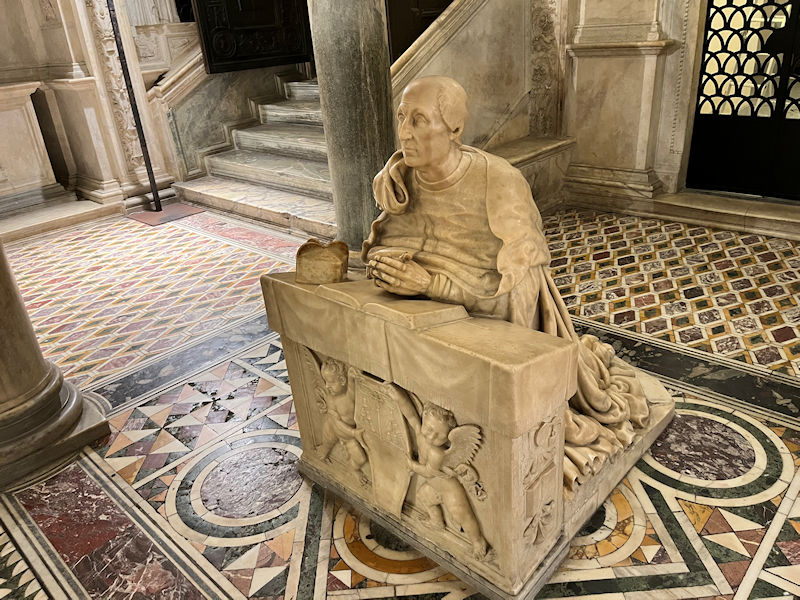
He looks a lot nicer than some of the popes we've seen in the same posture (like Pius IX).

Getting lost in a tangle of wall tombs

A side chapel with a crucifixion

The nave and its 17th century paintings

The nave and its pillars


Now it's time to revisit St Restituta's Basilica, a 4th century forerunner of the present establishment that's been kept on since the 14th century for us tourists.
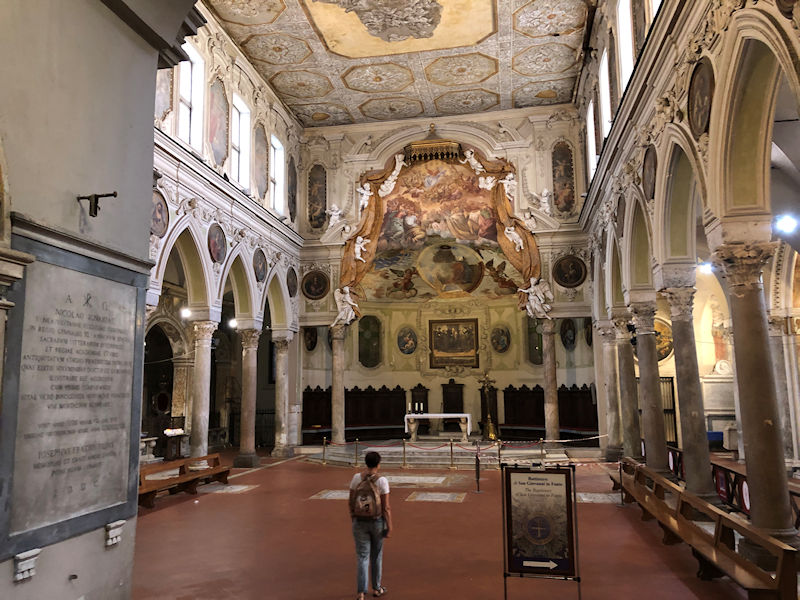
The Basilica di Santa Restituta is said to have been founded by the Emperor Constantine -- it was rebuilt and incorporated as an oversize side chapel into the cathedral when that was built in the 13th century. It's got a nave with two aisles divided by 27 very old columns and is a large but separate part of the Duomo.
Santa Restituta is said to have been a young African woman, who, because she was a Christian, was abandoned to the sea on a boat set ablaze. The fire died out, however, and she was miraculously able to put ashore on the island of Ischia. In the eighth century her remains were brought to the church in Naples that then took her name.

Various vestiges of the deep past have been found by archaeologists during work under the cathedral between 1969 and 1972: remains of a Greek wall originally part of a temple to Apollo, the peristyle of a late Roman domus under the apse, and a stretch of a Roman aqueduct and a Greek road. All of this is in a subterranean archaeological zone and not available to the public (the last we heard; it might be opening up by now, as part of the 'complesso monumentale').
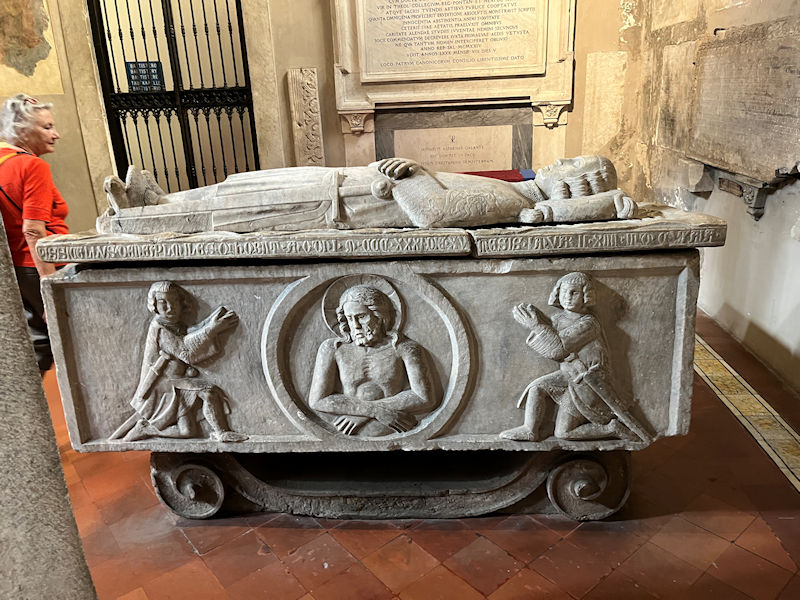
Down the right aisle of the nave, we come to a few old friends, like this worthy knight, who (though we can't see it from this angle) gets two faithful dogs at his feet instead of the regulation one.

And like this interesting embellishment to an elaborate sarcophagus just below.

Which brings us to this old door, into . . .

. . . this Paleochristian baptistry, the Baptistry of St Giovanni in Fonte, possibly commissioned by Constantine or more likely by the Bishop Severus in the late 4th century, and remodeled by Soter, Bishop of Naples from 465 to 486. It was once in its own building, but is now reached through the chapel behind the apse of St Restituta, as well as through a porch on the far side connecting it to the Archbishops' Palace.
Since the basin isn't deep enough for a full immersion, it's concluded that the clients stood in the centre and the water was poured over their heads three times.

This is considered to be Europe's oldest extant baptistry. The dome above is decorated with the early Christian Chi Rho and the Alpha-Omega symbols, and . . . .

. . . there are other rather badly damaged frescoes of Christian bible stories up the sides of the dome.

An early squinty version of a non-Pantocrator Jesus, and . . .

. . . presumably, the Madonna.

A long, last view of the dome, before we . . .

. . . leave the baptistery and return to St Restituta's main nave.

Interesting chapels on the far side

The rather spare altar in the well-ornamented apse


And at the far end of the left aisle, there is this mosaic, called Madonna del Principio, created by Lello da Orvieto in about 1322.


The organ above the entrance dates from 1750 -- there is a new ceiling added in the 18th century with a new fresco added in the centre (not visible in this photo) attributed to Luca Giordano.
The Basilica di San Lorenzo
Now for the Complesso Monumentale San Lorenzo Maggiore, still undergoing renovations (that photo is from this time last year, and nothing appears to have changed).
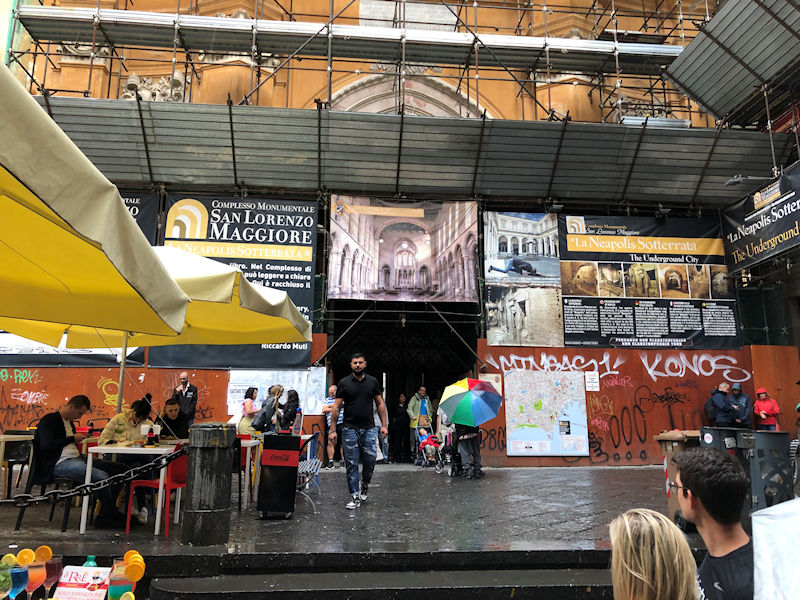
We have a few photos to plop up here this time, but we're not doing any justice to what's available here. For one thing, there is now a new museum that we haven't visited yet -- we'll have to come back, someday. In the meantime, we had a fairly thorough camera-waltz through the basilica itself last year, with quite a few more photos of some of the best aristocratic wall tombs (that's here) and we'll be back here in a few days with some more time to wander about.

The new ruler of Naples and the south, Charles I of Anjou, commissioned this church in 1270 for the Franciscan Order, apparently in compensation for having taken over their church for the construction of his new fortress, the Castel Nuovo. It's on the site of a 6th century Christian church which was itself built on the forum and marketplaces of the ancient city (much of which has been and is being excavated and open to the public since 1992).

The glass windows under the floor of the transept allow views of the very early mosaic flooring below, amongst the recent excavations. They were part of the sacristy of the early Christian basilica of the 6th century, where sacred vestments etc. were stored.

This is the ornate Cappellone of Saint Anthony in the back wall of the left transept, a baroque work by Cosimo Fanzago in 1638.

The church is located at the precise geographic centre of the ancient Greek-Roman city, at the intersection of via San Gregorio Armeno ('Christmas Alley') and via dei Tribunali (the decumanus maximus of the Roman grid).

The ambulatory behind the altar

We collect photographs of Kristin with her finger in lions' mouths.

This is the funeral monument of Ludovico Caracciolo, made in 1335, with cute little telamons of Justice and Charity.

Jesus with a crown of thorns and bound hands and what appears to be a gentle smile of understanding.

Very interesting (but so far unidentified by us)

By the way, in this church Boccaccio met his beloved Fiammetta in 1338.
We've had to hurry through this, and it's ridiculous -- we'll have to engineer a more thorough go at it in another day or two.

But now it's dinnertime, Callooh! Callay! The Donna Luisella is just next door to our flat, in fact it's all sort of in the same complicated building.
 Dwight Peck's personal website
Dwight Peck's personal website


























































